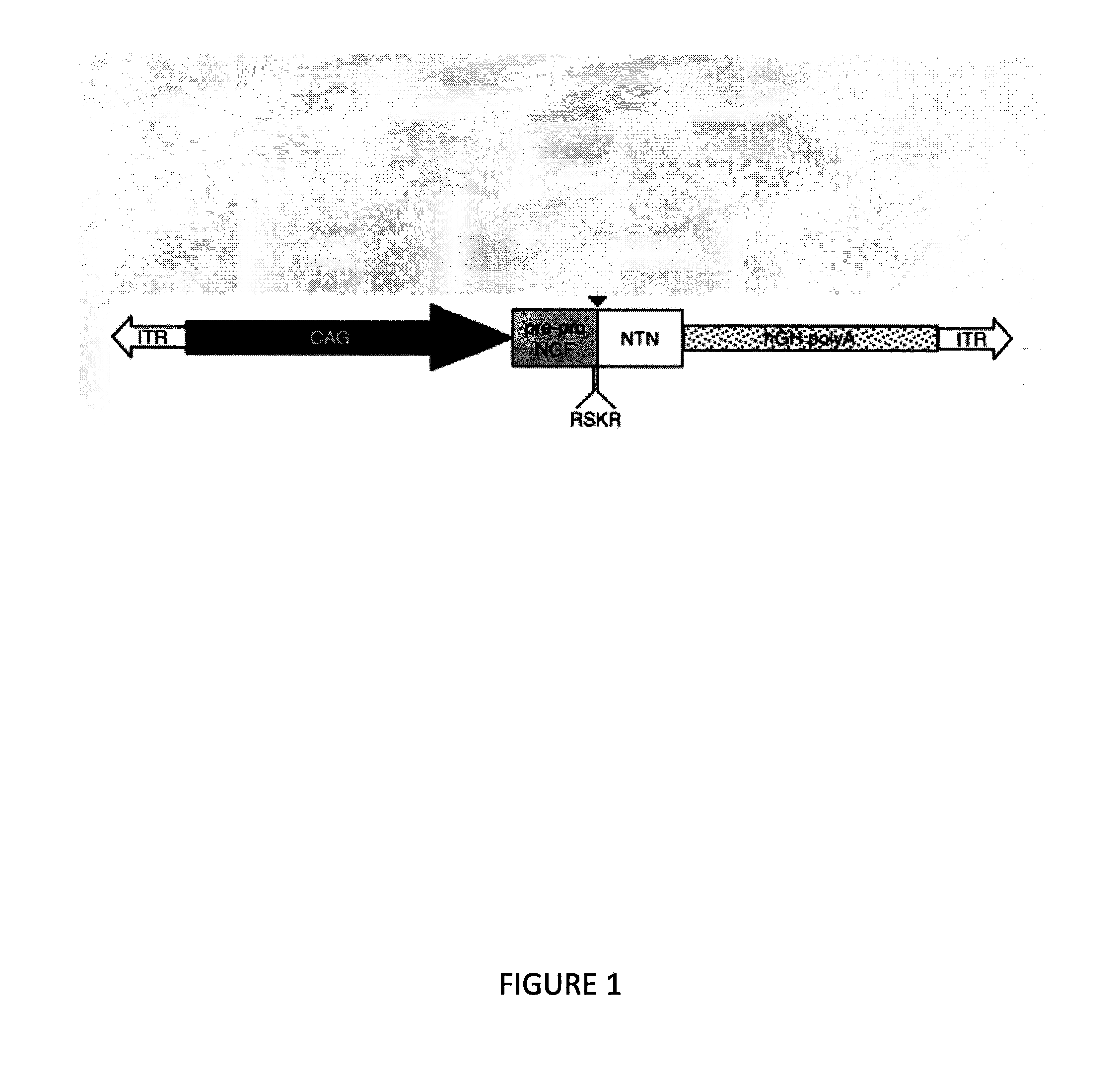Methods for treating parkinson's disease and other disorders of dopaminergic neurons of the brain
a dopaminergic and brain disorder technology, applied in the field of neurodegenerative diseases, can solve the problems of chronic levodopa treatment being associated with motor complications, no treatment protects against the continued degeneration of these neurons, and all therapies fail
- Summary
- Abstract
- Description
- Claims
- Application Information
AI Technical Summary
Benefits of technology
Problems solved by technology
Method used
Image
Examples
example 1
Bioactivity of AAV2-Neurturin Gene Therapy (AAV-Neurturin): Differences Between Parkinson's Disease and Nonhuman Primate Brains
[0085]A Phase 1 trial in 12 moderately advanced Parkinson's disease patients identified no safety issues, while suggesting possible improvement on several measures of motor function. Marks et al., Lancet Neurol 7:400-408 (2008). As noted elsewhere above, a subsequent double-blind-controlled Phase 2 trial in 58 subjects further supported the safety of AAV-neurturin, but failed to discern any benefit compared to sham surgery on the primary endpoint (UPDRS-motor-“off” at 12-months). However, several secondary endpoints suggested modest clinical benefit, while no measurement favored sham-control. Moreover, a protocol-prescribed analysis of all data from patients whose treatment remained blinded at 15 to 18 months (n=30) suggested significant benefit with AAV-neurturin (AAV2-NTRN) on the primary and secondary endpoints with no measurement favoring sham.
[0086]Two ...
example ii
Multicenter, Randomized, Double-Blind, Sham Surgery-Controlled Study of Intraputaminal AAV2-Neurtin (AAV-Neurturin) for Advanced Parkinson's Disease
[0116]AAV2 vector was genetically engineered to express only human neurturin (NRTN) as discussed in Example I and Gasmi et al., Mol Ther 15:62-68 (2007). It provides targeted and sustained delivery of neurturin (NRTN) to cells of the brain.
[0117]To conduct the multicentre, double-blind, sham-surgery controlled trial using AAV2-NRTN patients were randomly assigned (2:1) by a central, computer generated, randomization code to receive either AAV2-neurturin (5.4×1011 vector genomes) injected bilaterally into the putamen or sham surgery. All patients and study personnel with the exception of the neurosurgical team were masked to treatment assignment. The primary endpoint was change from baseline to 12 months in the motor subscore of the unified Parkinson's disease rating scale in the practically-defined off state. All randomly assigned patien...
example iii
Delivery of AAV-Neurturin to the Substantia Nigra and Putamen
[0119]AAV2-neurturin is being utilized in a Phase 2b multi-center, sham-surgery, double-blinded controlled trial in advanced Parkinson's disease initiated in October 2010. Advanced patients can be expected to have greater degeneration of their nigrastriatal transport pathways than patients in earlier stages of the disease, in which the invention is therefore expected to readily demonstrate efficacy. As of this filing, approximately 20 percent of the 52 subjects have undergone either CERE-120 administration or sham surgery, with many others enrolled and awaiting surgery. The protocol employs the present invention along the parameters outlined below.
[0120]Stereotactic surgery is done with neuroimaging to plan injection trajectories. Patients are anaesthetized with deep propofol sedation. For patients assigned to active treatment, a gene transfer procedure is done with AAV2 as a vector to deliver DNA-encoding neurturin to the...
PUM
| Property | Measurement | Unit |
|---|---|---|
| Time | aaaaa | aaaaa |
| Time | aaaaa | aaaaa |
| Time | aaaaa | aaaaa |
Abstract
Description
Claims
Application Information
 Login to View More
Login to View More - R&D
- Intellectual Property
- Life Sciences
- Materials
- Tech Scout
- Unparalleled Data Quality
- Higher Quality Content
- 60% Fewer Hallucinations
Browse by: Latest US Patents, China's latest patents, Technical Efficacy Thesaurus, Application Domain, Technology Topic, Popular Technical Reports.
© 2025 PatSnap. All rights reserved.Legal|Privacy policy|Modern Slavery Act Transparency Statement|Sitemap|About US| Contact US: help@patsnap.com

